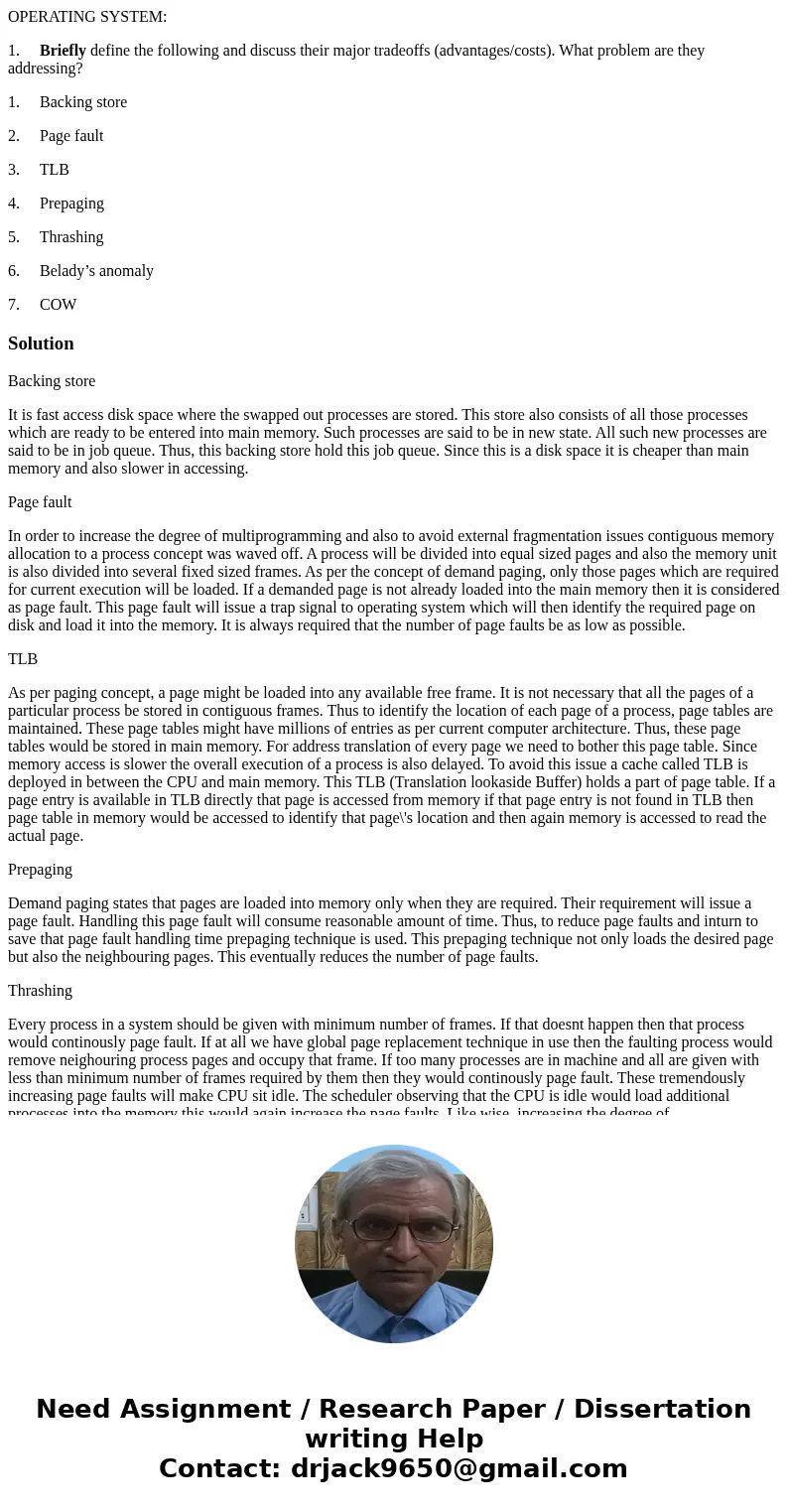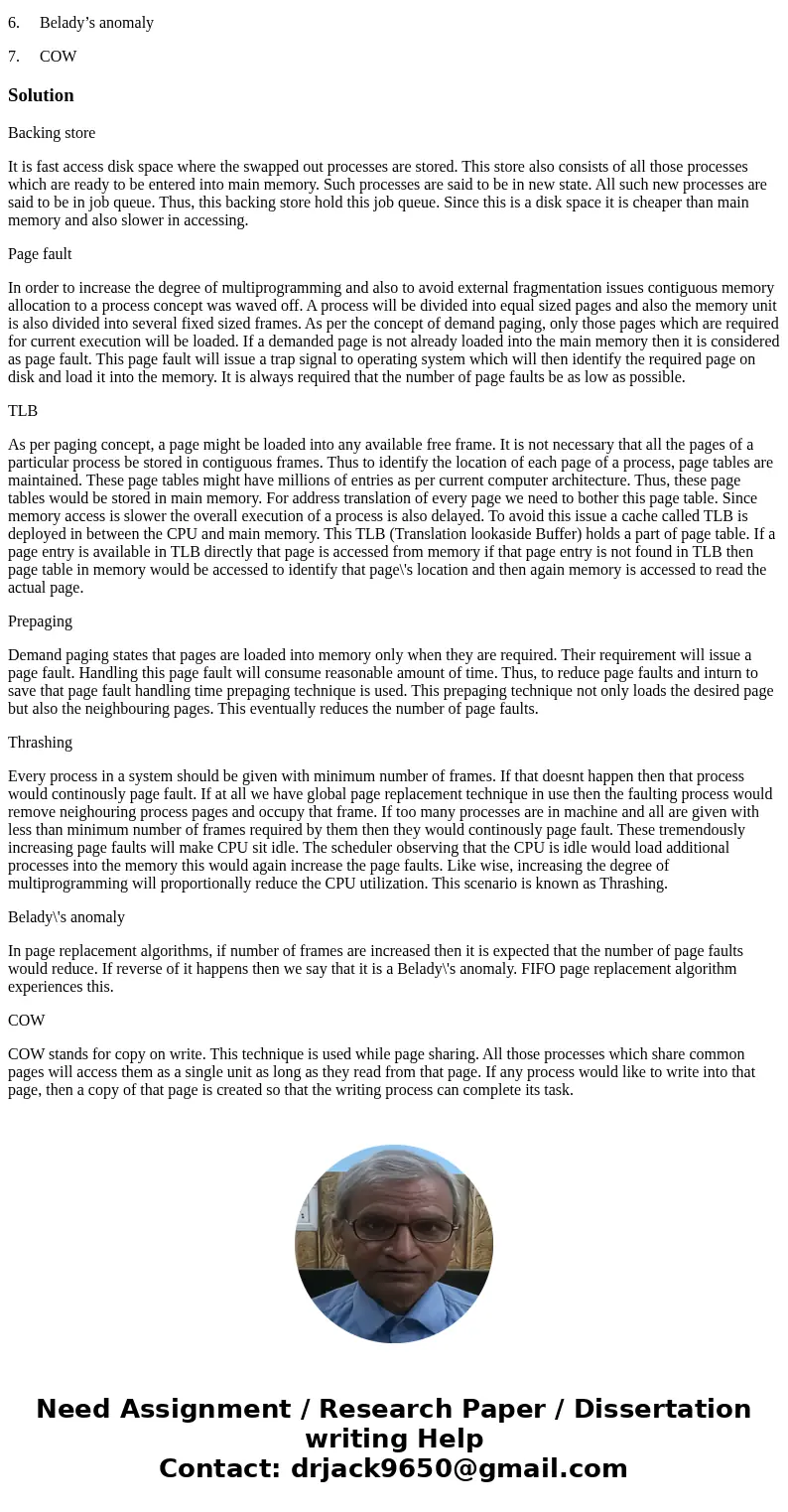OPERATING SYSTEM 1 Briefly define the following and discuss
OPERATING SYSTEM:
1. Briefly define the following and discuss their major tradeoffs (advantages/costs). What problem are they addressing?
1. Backing store
2. Page fault
3. TLB
4. Prepaging
5. Thrashing
6. Belady’s anomaly
7. COW
Solution
Backing store
It is fast access disk space where the swapped out processes are stored. This store also consists of all those processes which are ready to be entered into main memory. Such processes are said to be in new state. All such new processes are said to be in job queue. Thus, this backing store hold this job queue. Since this is a disk space it is cheaper than main memory and also slower in accessing.
Page fault
In order to increase the degree of multiprogramming and also to avoid external fragmentation issues contiguous memory allocation to a process concept was waved off. A process will be divided into equal sized pages and also the memory unit is also divided into several fixed sized frames. As per the concept of demand paging, only those pages which are required for current execution will be loaded. If a demanded page is not already loaded into the main memory then it is considered as page fault. This page fault will issue a trap signal to operating system which will then identify the required page on disk and load it into the memory. It is always required that the number of page faults be as low as possible.
TLB
As per paging concept, a page might be loaded into any available free frame. It is not necessary that all the pages of a particular process be stored in contiguous frames. Thus to identify the location of each page of a process, page tables are maintained. These page tables might have millions of entries as per current computer architecture. Thus, these page tables would be stored in main memory. For address translation of every page we need to bother this page table. Since memory access is slower the overall execution of a process is also delayed. To avoid this issue a cache called TLB is deployed in between the CPU and main memory. This TLB (Translation lookaside Buffer) holds a part of page table. If a page entry is available in TLB directly that page is accessed from memory if that page entry is not found in TLB then page table in memory would be accessed to identify that page\'s location and then again memory is accessed to read the actual page.
Prepaging
Demand paging states that pages are loaded into memory only when they are required. Their requirement will issue a page fault. Handling this page fault will consume reasonable amount of time. Thus, to reduce page faults and inturn to save that page fault handling time prepaging technique is used. This prepaging technique not only loads the desired page but also the neighbouring pages. This eventually reduces the number of page faults.
Thrashing
Every process in a system should be given with minimum number of frames. If that doesnt happen then that process would continously page fault. If at all we have global page replacement technique in use then the faulting process would remove neighouring process pages and occupy that frame. If too many processes are in machine and all are given with less than minimum number of frames required by them then they would continously page fault. These tremendously increasing page faults will make CPU sit idle. The scheduler observing that the CPU is idle would load additional processes into the memory this would again increase the page faults. Like wise, increasing the degree of multiprogramming will proportionally reduce the CPU utilization. This scenario is known as Thrashing.
Belady\'s anomaly
In page replacement algorithms, if number of frames are increased then it is expected that the number of page faults would reduce. If reverse of it happens then we say that it is a Belady\'s anomaly. FIFO page replacement algorithm experiences this.
COW
COW stands for copy on write. This technique is used while page sharing. All those processes which share common pages will access them as a single unit as long as they read from that page. If any process would like to write into that page, then a copy of that page is created so that the writing process can complete its task.


 Homework Sourse
Homework Sourse